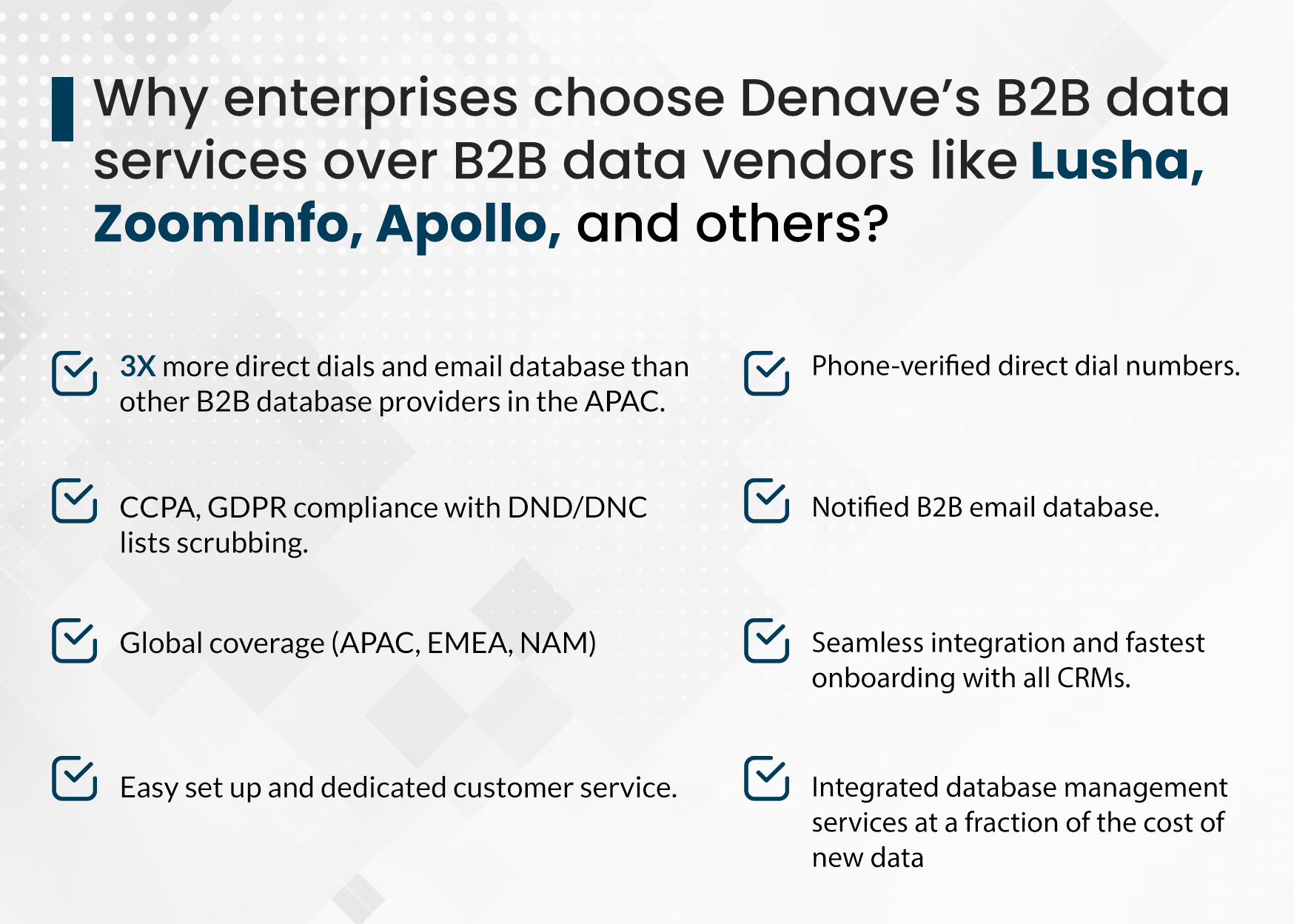News flash: churning out cold emails and cold calls is not going to earn you higher sales results.
Enterprises today need high-quality B2B data with comprehensive insights to drive higher connects, appointments, and deal conversions.
Imagine a scenario where you could foresee and predict your prospect’s next course of action. Thanks to improvements in data collection and management, forecasting prospect behaviour and building predictive intelligence can now have a transformative impact on the sales and marketing efforts. The B2B demand generation leaders who understand the importance of B2B data and integrate different data types into their sales and marketing processes to generate revenue more efficiently.
What is predictive intelligence?
Prediction intelligence is a new type of business insight and analysis that allows businesses to forecast prospect and buyer behaviour. It is a combination of various customer attributes such as technographic, firmographic information along with real-time market signals such as regulatory filings, funding rounds, and proprietary investments to suggest right fit prospects for go-to-market teams.
For sales, predictive insights can pinpoint the leads that have potential to convert, streamline lead scoring, and build personalized outreach for better engagement. For marketing, predictive data can be used to tailor messaging, campaigns, channels, along with audience segmentation and budget optimization.
When used in conjunction with right outreach cadences, predictive data intelligence can help B2B demand generation teams address the prospect pain points and package the best solution for qualified customers, saving time and budgets. There are three quintessential B2B data involved in building predictive sales intelligence: Fit, Opportunity, and Intent.
3 Important B2B Data Types Required for Predictive Intelligence
B2B sales intelligence can only be predictive when technographic, firmographic, along with granular account and prospect details fit together. The score of a prospect’s purchasing intent can be measured by joining market fit, opportunity, and behavioural signals.
Market Fit Data
Market fit data is primarily about fitting the bill of your target addressable market i.e., the right contact at the right company. A clearly defined company and contact database profile is the starting point for any kind of prospect segmentation or predictive scoring. B2B contact database company provides the foundation for kickstarting any sales, marketing, or B2B demand generation campaigns. If the account or the contact is not the right fit for your products/services, all other information (however accurate and detailed) has no value.
Market fit data typically includes basic firmographic, demographic, and technographic information at the company and contact level.
These include data points such as:
• Industry
• Job function
• Budget
• Technology Stack
• Location
• Any empanelled agencies or contact services
Typically, companies say that department budget and job title are effective at predicting a prospect’s intent to make a purchase. This is true partly because job title and department budget are fundamental to every lead generation and sales prospecting campaign. Consider this, even if every other piece of information in your B2B database is perfect, a prospect without the decision-making power and no budget authority would likely be a wasted effort for prospecting.
Opportunity Data
Opportunity data is usually the second layer of B2B data that helps marketing leaders to identify the right prospects with the right timing and conditions for making a purchase. Opportunity data is nothing but activities of an account or a prospect that suggest a favourable condition for purchase.
These data points include:
• Changes in CXOs, C-suites across target accounts
• New investments
• Pain points
• Sales & marketing initiatives
• Technology initiatives
• Funding
• Mergers & Acquisitions
• Hiring, layoffs, and promotions
Intent Data
The third key data set critical for predictive intelligence is intent data. These are sales signals that connects a prospect to a particular product/solution.
This includes, but not limited to:
• Form fills on website
• Content engagement
• Search term analysis
• Social media activities
• Email activities
• Engagement with sales reps
• Competitor research
However, one of the most effective indicators of an intent to purchase is when your target prospects are evaluating vendors in your market. This indicates that at this point prospects have narrowed down their options and is likely to make a purchase soon. Marketing automation systems and AI-led tools collect multiple layers of intent data from a variety of sources.
How to Use B2B Predictive Data in Sales & Marketing?
1. Accurate lead scoring: B2B marketers often score the sales readiness of their prospects based on a singular or incomplete data. Predictive intelligence offers a near complete information package that allows them to better track, score, nurture, and route leads for conversions. Predictive intelligence maps the entire footprint of a prospect, right from company size, location to website visits and past purchase history. Based on these insights, marketers can build insight-based nurture plan and sales reps can foresee the maturity of prospects who are ready to buy.
2. Dynamic customer outreach: Predictive intelligence coupled with GenAI leverages allow B2B demand generation leaders to build hyper-personalized dynamic prospect targeting. Based on the prospect behaviour, their social media activities, and past interactions with your brand, you can tailor your communication, build relevant content, and offer personalized recommendations- drastically enhancing customer experiences across channels.
3. Improve email marketing outcomes: One-size-fits-all approach to email marketing is no longer applicable in today’s complex buyer journeys. Value-driven email marketing with personalization across different parameters such as pain points, buying preferences, etc., are critical for email marketing success.
Conclusion
By mapping and tagging customer insights and behavioural patterns, B2B marketing and sales leaders can leverage predictive insights to build personalized campaigns and deliver unified experiences across channels. Combined with the right marketing automation and AI tools, they can connect with the right prospect at the right time with the right offer. Companies can also leverage predictive intelligence to build unique use cases for sales teams so that every pitch is led by the right person.
Read Responses
No Comments
Leave a Reply
Your email address will not be published.


